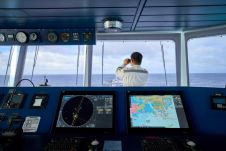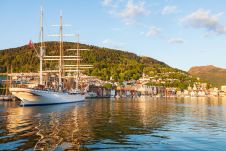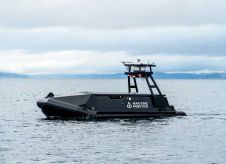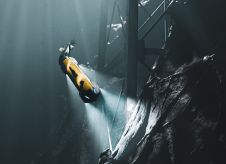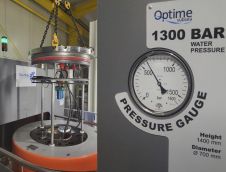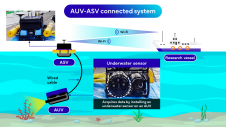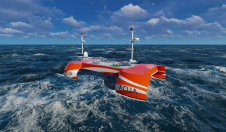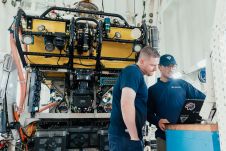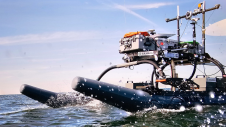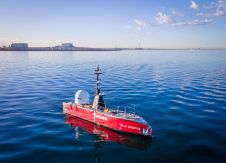Energy Business Analyst
Hydro International Interviews Adam Westwood
The European Union has set a target stating that a 20% share of energy should come from renewable sources by 2020. Electricity systems will have to incorporate more renewable energy from a variety of sources. Douglas-Westwood, an independent employee-owned company, is one of the world’s leading providers of business research and analysis, strategy and commercial due diligence on the global energy services sectors. The company’s work in analysing the renewable energy business has spanned all of the grid-connected electricity generation sectors. Noted for its extensive knowledge of the marine renewable sectors including offshore wind, wave and tidal energy systems, Douglas-Westwood continually monitors all of the world’s existing and proposed projects. We caught up with Adam Westwood, the company’s renewable energy manager and an acknowledged expert on renewable energy projects, to find out more about Douglas-Westwood’s research activities and his own particular area of interest, offshore wind.<P>
What is your background?
I joined Douglas-Westwood seven years ago after I completed a degree in sociology.
How did you develop an interest in the global renewable energy services sector?
When I first joined Douglas-Westwood, the potential of renewable energy was an area of interest that the business was beginning to develop. The company had just started working in the sector and I was able to begin my career there focusing on renewable energy projects.
What are your key interests/research areas in the sector?
My main interests lie in the offshore wind sector, particularly within supply chain development and technology advancement.
The industry is moving quickly, and construction and tendering activity is at an all-time high. Offshore wind is forecast to see EUR21 billion of capital expenditure in the coming five-year period as 6.5GW of new capacity is installed. With just over 1.5GW of capacity currently installed, this represents significant market growth and will lead to an annual capital expenditure of over EUR5.6 billion by 2013. The new edition of The World Offshore Wind Market Report examines the current and future prospects, technologies and markets for the offshore wind energy sector. It is the definitive report in the sector; it is used by investment banks, manufacturing and installation contractors, and government departments. Each proposed offshore wind farm worldwide is assessed in-house and we model unique and detailed market information. The report provides forecasts of capital expenditure and installed capacity, split by country, plus forecasts for numbers, size and type of turbines, foundations, cables and their associated capital expenditure.
What are the key components of the research you do in renewable energy?
Douglas-Westwood undertakes commissioned market research, commercial due diligence and publishes a range of sector reports on the energy industry. The key components of the work are a wide understanding of the energy sector as a whole, as this ultimately drives the demand for renewable energy.
Knowledge of the finance sector is proving increasingly useful, as more and more projects require bank financing; we are seeing a growing number of deals in the industry as a function of companies seeking to integrate component suppliers, control installation assets and finance their expansion.
What are the most critical global considerations of the renewable energy forecasts being produced by Douglas-Westwood?
Global considerations are indeed required. The energy industry is truly international and it is therefore vital to analyse its nature. The state of the oil and gas industry has already been seen to have a direct impact on the offshore renewables supply chain.
High oil prices drive demand for shipbuilding, heavy lift vessels, cables, cable laying, personnel and so on. We look globally in our market research. One of the most important factors is to understand the different drivers in each country and how these may affect project development and investment.
Douglas-Westwood is known for its extensive knowledge of the marine renewable sectors including offshore wind, wave and tidal energy systems. What observations do you have regarding the world’s existing projects?
First and foremost, the sectors are still in their infancy. We expect significant technological improvement, even for the more established offshore wind sector. The offshore wind industry will change enormously and become more distinct from onshore – the two are extremely similar at present. With wave and tidal, we expect greater standardisation and hope for better reliability and survivability.
How is the current economic environment impacting the renewable energy sector?
One of the fundamental issues at present is that of cost. We’ve seen a 250% cost increase in six years offshore. Many projects are at the very limit and cannot proceed under the current circumstances. Project development is now almost exclusively the role of utility companies, but they have moved from balance-sheet financing to project financing. The high costs being seen have limited the availability of financing, causing delays to even the strongest projects due to the economic slump.
Increasingly, we expect to see abandonment of projects due to prohibitive costs. More focus is needed on site selection and design.
Investment in the supply chain has taken place, both in terms of manufacturing and installation, but demands from new, larger projects are increasing. The UK’s recent temporary boost to its main market mechanism has allowed some major projects to move forward (such as London Array) but the extra demand created for elements of the supply chain will not encourage downward movement on prices. Fortunately, the depressed oil price has meant that some costs have reduced and offshore contractors operating across different sectors are more available for offshore wind work. It also has a knock-on effect on freeing up shipyards for vessel construction, and contributes to lowering the price of other commodities. The fall in steel prices is extremely good news for the offshore wind industry and is having a distinct impact on prices.
What are the major challenges to renewable energy and is enough being done to confront them?
In addition to finance, the major challenges are legislation, transmission/grid and technology. There must be long-term commitment to the contribution of renewable energy to countries’ energy mixes. Short-term, fluctuating levels of support create uncertainty, which make investment difficult. Clear, long-term political support, structured market mechanisms and supply chain stimulation is required by government.
Grid/transmission capacity is problematic, especially for countries such as the UK, but steps are being taken to address the problems and generate access and transmission capacity. Increases in electricity trading and enabling concepts such as the Supergrid must be supported.
Technology has to improve. We’re doing offshore wind very inefficiently at present. Increasing reliability, availability and operability are crucial. Turbine technology has a long way to go to stand up against offshore oil and gas technology, which operates in far harsher environments with less intervention.
‘Floating’ foundations are now seeing notable successes; these must be extensively trialled and developed as they offer greater resource capture and potentially lower costs. Installation and commissioning needs to be quicker, for both cost and safety reasons. Building turbines in sections offshore is not the ideal methodology as we move forward, for instance.
What are the factors that will impact the renewable energy sector over the next five years?
Increasing energy prices, security of supply concerns, political will, technology advancement and profitability are all key considerations for the future.
What is the single most important fact about renewable energy that you wish people knew more about?
Renewable energy is supplied from renewable energy sources – there are so many positives inherent in that compared with traditional fossil fuels, from the obvious environmental protection benefits to the advantages that come with having security of supply.

Value staying current with hydrography?
Stay on the map with our expertly curated newsletters.
We provide educational insights, industry updates, and inspiring stories from the world of hydrography to help you learn, grow, and navigate your field with confidence. Don't miss out - subscribe today and ensure you're always informed, educated, and inspired by the latest in hydrographic technology and research.
Choose your newsletter(s)












